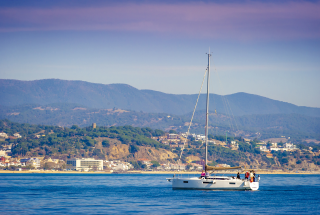Professional tourism mitigated the impact of the shift in Easter holidays on tourism activity in March
06/05/2025 - 12:00h
The latest monthly tourism activity data in Destination Barcelona have been updated
The Barcelona Tourism Observatory: city and region presents the analysis of the main monthly indicators monitoring tourism activity corresponding to March 2025 in Destination Barcelona. It is important to consider the shift in the calendar of some major events when comparing year-on-year data: for example, the MWC in 2024 took place in February, while in 2025 it was held in March. Conversely, Easter in 2024 was in March, whereas in 2025 it was in April.
Below are the main conclusions, by geographic area, highlighting the most relevant aspects of this update:
Barcelona city
- Hotels and guesthouses accounted for 680 establishments and more than 87,000 operational beds, exceeding both February and the same month of the previous year (+0.3% Var. 25/24 in bedplaces).
- Demand for hotels, guesthouses, and Homes for Tourist Use (HTUs) increased compared to the previous month in terms of overnight stays, due to the effect of tourism seasonality. However, when compared year-over-year, despite the number of tourists increasing (+6.4% Var. 25/24), the average length of stay was shorter (from 3.0 nights in 2024 to 2.8 in 2025), which led the number of overnight stays to be similar to last year's (-0.3% Var. 25/24).
- By type of accommodation, the average stay was 2.4 nights in hotel establishments and 3.7 nights in HTUs. Meanwhile, the occupancy rate in hotels was 63.4% (-3.9 pp Var. 25/24), while in HTUs, it was 59.9% (+6.1 pp Var. 25/24).
- At Barcelona Airport, there were 4.4 million passenger movements, meaning a +1.7% year-over-year increase. The ranking of countries from which passengers arrived on flights to Barcelona Airport was led by Spain, followed by Italy, the United Kingdom, Germany, and France.
- At Barcelona Port, there were nearly 150,000 cruise passenger movements and almost 88,000 ferry passenger movements. In both cases, this represents a month-over-month decrease due to cruise seasonality, but although cruise passenger movements grew year-over-year (+10.8% Var. 25/24), ferry passenger movements decreased (-28.0% Var. 25/24).
- In the monitored cultural facilities of the ICUB, approximately the same number of visitors was recorded as the previous month, but with a year-on-year decrease of -6.8%. However, it is worth noting that the proportion of international visitors increased compared to the previous month: while in February they accounted for 58.3%, in March they represented 64.2%, a very similar level to that of March 2024.
- Regarding the origin of tourists, in hotel establishments, the proportion of international visitors was 80.8%, ahead of the previous month (+2,6pp). The ranking of tourists in this type of accommodation was led by residents of Spain (19.3% share), followed by residents of the United States (12.6%), Italy (6.9%), and the United Kingdom (6.8%).
- The typical tourist in Barcelona1 during this month was a 37-year-old traveler, most commonly visiting as a solo (36.7%). Those traveling for professional reasons increased up to 49.0% of the total, followed by leisure travelers (44.0%) and those traveling for personal reasons (6.6%).
- The average expenditure during the stay in the city increased sharply compared not only to the previous month (+52.4%), but year-over-year (+71.6%), reaching €149.3 per person per day. This was due to the increase in professional tourism, mainly driven by the calendar shift of the MWC, which, as previously mentioned, was held in February in 2024, while this year it took place in March. Nonetheless, it is worth highlighting that this average monthly expenditure is the highest of the last 5 years.
- Spending during the stay in the city was primarily allocated to food and beverages (43.2%), followed by shoping for clothes, footwear, and others (21.7%), and entertainment, leisure, and culture (18.3%).
- Regarding the labor market, in March, new hiring in the core tourism sector increased compared to the previous month, but decreased year-over-year (-5.2% Var. 25/24). However, permanent contracts in the city outnumbered temporary ones once again (53.8% vs. 46.2%), and registered unemployment in the tourism activity was lower than in the same period in 2024 (-3.2% Var. 25/24).
Barcelona region
- The operational supply of tourist accommodation in Barcelona region also increased year-on-year due to the effect of tourism seasonality. However, including hotel establishments, campsites, and rural tourism, 58,000 places were open, which means -6.6% year-over-year. In this case, the postponement of Easter by one month explains why the reopening of establishments occurred at a different level than last year.
- Tourist demand also grew month-on-month due to seasonality, but due to the same reason explained right before, both the number of tourists and overnight stays decreased year-over-year (-11.9% and -12.5% Var. 25/24, respectively).
- As for the average length of stay, it kept quite stable compared to the previous year, at 2.4 nights. By type of accommodation, campsites once again recorded the longest stays (3.8 nights), followed by hotel establishments (2.2 nights) and rural tourism accommodation (2.1 nights). Regarding occupancy, campsites reported a 48.2% occupancy rate in bed places (-0.8pp Var. 25/24), and rural tourism establishments recorded 16.7% (-3.4pp Var. 25/24).
- 50.8% of tourists in hotel establishments in Barcelona region were international, a higher proportion than in the previous month (+6.5pp).
- The typical tourist in Barcelona region during this month1 was a 49-year-old individual who traveled for leisure (46.7%) and as a couple (39.6%). The average expenditure during the stay was €48.1 per person per day, which decreased significantly compared to the previous month (-7.1%) but increased year-over-year (+16.5% Var. 25/24). Taking into account spending in Barcelona city, the average expense in Destination Barcelona was €119.1 (+64.2% Var. 25/24).
- Expenditure during the stay in Barcelona region was mainly allocated to food and beverages (67.7%) and shopping for clothing, footwear, and other items (13.2%).
- Employment in the tourism activity in Barcelona region grew clearly compared to the previous month and year-over-year (+5.7% Var. 25/24). Moreover, permanent contracts continued to outnumber temporary ones (52.7% vs. 47.4%), and registered unemployment decreased by -3.0% year-over-year.
Based on quarterly closing data, the city of Barcelona received a total of 3.2M tourists from January to March 2025, which when combined with the 1.5M tourists in Barcelona region, resulted in Destination Barcelona welcoming a total of 4.7M visitors. These figures, together with spending on accommodation and expenditure during the stay, allowed the estimation of the economic impact of direct tourist activity spending, amounting to a total of €2,451M for the entire destination. This impact was distributed as €2,019M in Barcelona city and €432M in Barcelona region. It is worth noting that, although the total number of tourists across Destination Barcelona decreased by -5.5% compared to the first quarter of 2024 (-1.4% in the city and -13.3% in the region), the economic impact has registered a +7.4%-year-on-year growth (+9.0% in the city and +0.4% in the region). These calculations include data from paid tourist accommodations as well as other types of lodging without economic transactions, such as staying with friends and family.
___________________________________________________________________________
1 For more information on the profile and habits of tourists during February in Destination Barcelona, please click on the following link.
More information:
Summary of tourism activity in Destination Barcelona - March 2025
Tourism activity interactive report
Share:


